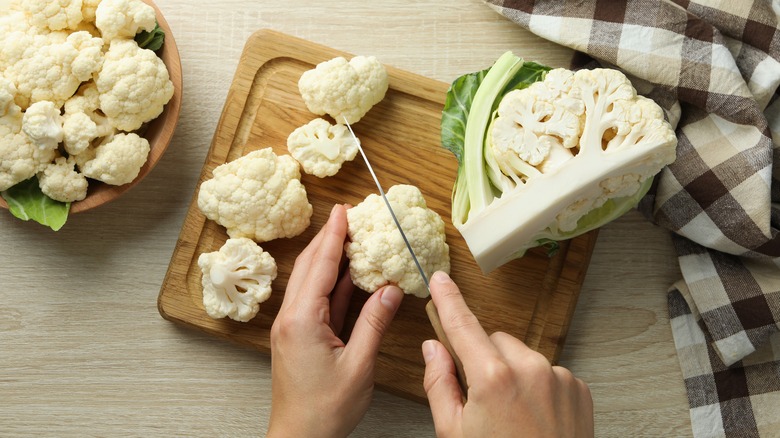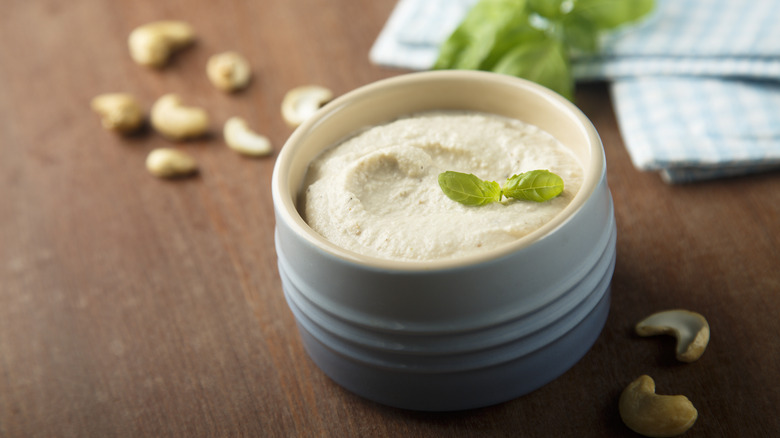The Secret Ingredient For Creamy Tomato Soup Without Dairy
Getting a luxuriously creamy tomato soup without using dairy might seem difficult, but there are a few plant-based ingredients that can help you achieve this. An easy method is to simmer and then puree cauliflower with your soup, which will ultimately create a silky-smooth and decadent consistency.
Blended cauliflower is a common vegan replacement for cream. Once it has been cooked until ultra-tender, the vegetable can be pulverized into a thick, creamy, sauce-like texture. Simmering it with the tomatoes, onions, and other flavorings of your soup allows it to absorb their tastes. However, if you prefer to develop the flavor of cauliflower separately, you can cook it on its own. Either way, the vegetable will be neutral enough that it will not overshadow the other ingredients you're working with. When it's time to finish the soup, you can use either an immersion or standing blender.
If you want to accentuate the sweet and nutty notes of cauliflower, try roasting it separately instead of simmering. This method allows the vegetable to brown and caramelize, bringing out its natural flavors. Just keep in mind that doing this will give the cauliflower a more prominent role in the soup you're making.
The many uses of cauliflower cream
Tomato soup is far from the only dish that cauliflower can help thicken and make creamy. Because this cruciferous vegetable has a fairly mild taste, it's highly adaptable. You can use it to replace béchamel for a dairy-free spin on a moussaka recipe, or substitute it for cream in a plant-based take on fettuccine alfredo. To make cauliflower cream, simply simmer the florets, and then blend them just as you would with a soup. Simmering the cauliflower with stock or aromatics will develop more flavor while using water will yield a more neutral-tasting cream. You could also add plant-based butter for extra richness.
Thickening a soup with cauliflower offers several interesting advantages over dairy. A cauliflower-based sauce is more stable, as milk and cream can curdle when heated. Dairy fat can also sometimes dull strong flavors in a soup or sauce. This can be beneficial when you need to balance an acidic ingredient. However, there are times when cream can overpower the delicate flavors of a soup. Cauliflower, on the other hand, lends creaminess without added fat and remains subtle, allowing your other ingredients to shine.
More creamy plant-based alternatives
If you want to increase the creaminess of your soup even further — still without adding dairy — you can turn to cashews. Simply toss a handful into your stock and other ingredients while they're simmering. Alternatively, you can soak cashews overnight and then blend them on their own. Either method allows them to soften and become pliable. It's crucial to use a high-speed blender to blitz everything together; otherwise, you'll be left with a gritty texture. However, when pulverized on high, the nuts will break down and impart significant creaminess to the soup. Use raw cashews, as they are softer and have a more neutral taste than roasted options. Try it out for a dairy-free recipe, like cashew queso.
Silken tofu is another powerful tool in your culinary arsenal. This ingredient stands out due to its extremely light, clean flavor profile. It works very well as the base for a vegan mayo, where its creaminess and body help emulsify the oil and acid without making the sauce taste like tofu. You can also puree it directly into a soup to leverage its thickening properties.
Need a non-dairy thickener but don't have a blender on hand? Turn to aquafaba, the starchy liquid in which canned chickpeas are packed. Simply add the liquid to your soup and simmer it for a few minutes. The starch will absorb some excess water and thicken the mixture right up.



